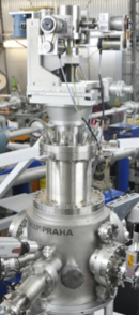Ion Beam Channeling (RBS/c)
Ruđer Bošković Institute in Zagreb
For maintenance reasons the ion beam Croatian facilty at the Ruđer Bošković Institute is partially operational. Currently, the Ion Beam Channeling (RBS/c) is not available. Please check out the other instruments offering limited access at the Ruđer Bošković Institute at the webpage Open Access Offer
Scattering chamber dedicated for the performance of ion beam channeling experiments is placed at the 15 degree beam line of the 6.0 MV Tandem van de Graaff accelerator. The same chamber can accept ions from the 1.0 MV Tandetron accelerator as well. Small divergence beams are collimated to the beam spot sizes of 1-3 mm, while the sample position is controlled by a motorized 6-axes goniometer. In addition, sample can be heated during the measurements up to the 600 degrees C .
When a crystalline sample is exposed to the ion beam, while the rows of atoms in the lattice are aligned parallel to the incident ion beam, an ion channeling will occur. The bombarding ion beam will backscatter from the first few monolayers of material at the same rate as a non-aligned sample, however the backscattering from buried atoms in the lattice will be drastically reduced, since these atoms are shielded from the incident ions by the atoms in the surface layers. By measuring the reduction in backscattering yield when a sample is channeled, it is possible quantitatively to measure and profile the crystal perfection of a sample and to determine its orientation. This technique is called RBS channeling (RBS/c). Channeled ions can also be used to observe the reduction in yield of the emitted characteristic x-rays, in which case the technique is called PIXE channeling (PIXE/c).

Technical specifications
For irradiation purposes, the beam from the 6.0 MV tandem or 1.0 MV tandem is collimated by a circular interchangeable apertures of 1, 3 and 5 mm diameter. The scattering chamber is also equipped with an RBS detector and also has the possibility of mounting an x-ray detector for PIXE.
Sample environment
Samples are positioned by motorized xyz stage and three-axis goniometer. The sample holder is circular, with a diameter of 2.5 cm. All samples have to be positioned within this holder and their maximum number therefore depends on the size of individual samples. Detailed information can be found on the instrument’s webpage.
-
20.02.2025
X-ray computed tomography (CT) TomoLab
-
23.01.2025
THz beamline TeraFERMI



